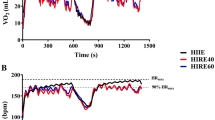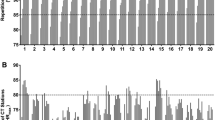Abstract
The purpose of this study was to determine the physiological effects of a programmed accommodating circuit exercise (PACE) program consisting of aerobic exercise and hydraulic-resistance exercise (HRE) on fitness in older adults. Thirty-five volunteers were randomly divided into two groups [PACE group (PG) 8 men and 10 women, 68.3 (4.9) years, and non-exercise control group (CG) 7 men and 10 women, 68.0 (3.4) years). The PG participated in a 12-week, 3 days per week supervised program consisting of 10 min warm-up and 30 min of PACE (moderate intensity HRE and aerobic movements at 70% of peak heart rate) followed by 10 min cool-down exercise. PACE increased (P<0.05) oxygen uptake (V̇O2) at lactate threshold [PG, pre 0.79 (0.20) l min−1, post 1.02 (0.22) l min−1, 29%; CG, pre 0.87 (0.14) l min−1, post 0.85 (0.15) l min−1, −2%] and at peak V̇O2 [PG, pre 1.36 (0.24) l min−1, post 1.56 (0.28) l min−1, 15%; CG, pre 1.32 (0.29) l min−1, post 1.37 (0.37) l min−1, 4%] in PG measured using an incremental cycle ergometer. Muscular strength evaluated by a HRE machine increased at low to high resistance dial settings for knee extension (9–52%), knee flexion (14–76%), back extension (18–92%) and flexion (50–70%), chest pull (6–28%) and press (3–17%), shoulder press (18–31%) and pull (26–85%), and leg press (21%). Body fat (sum of three skinfolds) decreased (16%), and high-density lipoprotein cholesterol (HDLC) increased (10.9 mg dl−1) for PG. There were no changes in any variables for CG. These results indicate that PACE training incorporating aerobic exercise and HRE elicits significant improvements in cardiorespiratory fitness, muscular strength, body composition, and HDLC for older adults. Therefore, PACE training is an effective well-rounded exercise program that can be utilized as a means to improve health-related components of fitness in older adults.

Similar content being viewed by others
References
American College of Sports Medicine (1998a) The recommended quantity and quality of exercise for developing and maintaining cardiorespiratory and muscular fitness, and flexibility in healthy adults. Med Sci Sports Exerc 30:975–991
American College of Sports Medicine (1998b) Exercise and physical activity for older adults. Position stand. Med Sci Sports Exerc 30:992–1008
Beaver WL, Wasserman K, Whipp BJ (1985) Improved detection of lactate threshold during exercise using a log–log transformation. J Appl Physiol 59:1936–1940
Bendall MJ, Bassey EJ, Pearson MB (1989) Factors affecting walking speed of elderly people. Age Aging 18:322–332
Brechue WF, Pollock ML (1996) Exercise testing for coronary artery disease in the elderly. Clin Geriatr Med 12:207–229
Brown AB, McCartney N, Sale DG (1990) Positive adaptations to weight-lifting training in the elderly. J Appl Physiol 69:1725–1733
Chrusch MJ, Chilibeck PD, Chad KE, Davidson KS, Burke DG (2001) Creatine supplementation combined with resistance training in older men. Med Sci Sports Exerc 33:2111–2117
Cooney MM, Walker JB (1986) Hydraulic resistance exercise benefits cardiovascular fitness of spinal cord injured. Med Sci Sports Exerc 18:522–525
Cress ME, Buchner DM, Questad KA, Esselman PC, deLateur BJ, Schwartz RS (1999) Exercise effects on physical functional performance in independent older adults. J Gerontol Med Sci 54A:M242–M248
Doherty TJ (2003) Invited review: Aging and sarcopenia. J Appl Physiol 954:1717–1727
Fiatarone MA, Evans WJ (1990) Exercise in the oldest old. Top Geriatr Rehab 5:63–77
Fiatarone MA, O’Neill EF, Ryan ND, Clements KM, Solares GR, Nelson ME, Roberts SB, Kehayias JJ, Lipsitz LA, Evans WJ (1994) Exercise training and nutritional supplementation for physical frailty in very elderly people. N Eng J Med 330:1760–1775
Friedewald W, Lavy RIT, Fredrickson DS (1972) Estimation of the concentration of low-density lipoprotein cholesterol in plasma, without use of the preparative ultracentrifuge. Clin Chem 18:499–502
Haennel RG, Quinney HA, Kappagoda CT (1991) Effects of hydraulic circuit training following coronary artery bypass surgery. Med Sci Sports Exerc 23:158–165
Hagerman F, Walsh SJ, Staron RS, Hikida RS, Gilders RM, Murray TF, Toma K, Ragg KE (2000) Effects of high-intensity resistance training on untrained older men. I. Strength, cardiovascular, and metabolic responses. J Gerontol 55A:B336–B346
Holloszy JO (1995) Sarcopenia: muscle atrophy in older age. J Gerontol 50A:1–161
Hunter GR, Wetzstein CJ, McLafferty CR Jr, Zuckerman PA, Landers KA, Bamman MM (2001). High-resistance versus variable-resistance training in older adults. Med Sci Sports Exerc 33:1759–1764
Huttunen JK, Lansimies E, Voutilainen E, Ehnholm C, Hietanen E, Penttila I, Siitonen O, Rauramaa R (1979) Effects of moderate physical exercise on serum lipoproteins. Circulation 60:1220–1229
Kasch FW, Boyer JL, Schmidt PK, Wells RH, Wallace JP, Verity LS, Guy H, Schneider D (1999) Ageing of the cardiovascular system during 33 years of aerobic exercise. Age Aging 28:531–536
Kelemen MH, Stewart KJ, Gillilan RE, Ewart CK, Valenti SA, Manley JD, Kelemen MD (1986) Circuit weight training in cardiac patients. J Am Coll Cardiol 7:38–42
Labarque V, T Eijnde BO, Van Leemputte M (2002) Resistance training alters torque–velocity relation of elbow flexors in elderly men. Med Sci Sports Exerc 34:851–856
MacCartney N, Hicks AL, Martin J, Weber CE (1996) A longitudinal trial of weight training in the elderly: continued improvements in year 2. J Gerontol Biol Sci 51A:B425–B433
Nakamura H, Uzawa H, Maeda H, Inomot T (1983) Physical fitness: its contribution in serum high-density lipoprotein. Atherosclerosis 48:173–183
National Safety Council (2000) Accident facts 2000. National Safety Council, Itasca, Ill.
Newton RU, Hakkinen K, Hakkinen A, McCormick M, Volek J, Kraemer WJ (2002) Mixed-methods resistance training increases power and strength of young and older men. Med Sci Sports Exerc 34:1367–1375
Okugawa M, Ichiie C, Noda Y (1998) The effect of PACE training in middle-aged and older women. In: Tanaka K, Noda Y (eds) PACE training. Mizuno, Osaka, Japan, pp 60–63
Puggaard L (2003) Effects of training on functional performance in 65-, 75- and 85-year-old women: experiences deriving from community based studies in Odense, Denmark. Scand J Med Sci Sports 13:70–76
Puggaard L, Pedersen HP, Sandager E, Klitgaard H (1994) Physical conditioning in elderly people. Scand J Med Sci Sports 4:47–56
Rogers MA, Evans WJ (1993) Changes in skeletal muscle with aging: effects of exercise training. Exerc Sports Sci Rev 21:65–102
Saku Y, Noh H, Nakagaichi M (1998) The effect of PACE training in middle-aged and older men. In: Tanaka K, Noda Y (eds) PACE training. Mizuno, Osaka, Japan, pp 57–59
Sidney KH, Shephard RJ, Harrison J (1977) Endurance training and body composition of the elderly. Am J Clin Nut 30:326–333
Stein RA, Michielli DW, Glantz MD, Sardy H, Cohen A, Goldberg N, Brown CD (1990) Effects of different exercise training intensities on lipoprotein cholesterol fractions in healthy middle-aged men. Am Heart J 119:277–283
Skelton DA (2001) Effects of physical activity on postural stability. Age Ageing 30[Suppl 4]:33–39
Skelton DA, Beyer N (2003) Exercise and injury prevention in older people. Scand J Med Sci Sports 13:77–85
Skelton DA, Young A, Greig CA, Malbut KE (1995) Effects of resistance training on strength, power and selected functional abilities of women aged 75 and over. J Am Geriatr Soc 43:1081–1087
Takeshima N, Tanaka L, Kobayashi F, Watanabe T, Kato T (1993) Effects of aerobic conditioning at intensities corresponding to lactate threshold in the elderly. Eur J Appl Physiol 67:138–143
Takeshima N, Rogers ME, Watanabe E, Brechue WF, Okada A, Yamada T, Islam MM, Hayano J (2002) Water-based exercise improves health-related aspects of fitness in older adult women. Med Sci Sports Exerc 34:544–551
Tanaka K (1998) PACE is a new exercise mode. In: Tanaka K, Noda Y (eds) PACE training. Mizuno, Osaka, Japan, pp 16–17
Tokyo Metropolitan University Laboratory of Physical Education (in Japanese) (1996) Physical fitness standards of Japanese people, 4th edn. Fumai-do, Tokyo
Wasserman K, Whipp BJ, Davis JA (1981) Respiratory physiology of exercise: metabolism, gas exchange, and ventilatory control. In: Widicombe JG (ed) International review of physiology—respiratory physiology III. University Park Press, Baltimore, pp 149–211
Weltman A, Janney C, Rians CB, Strand K, Berg B, Tippitt S, Wise J, Cahill BR, Katch FI (1986) The effects of hydraulic resistance strength training in pre-pubertal males. Med Sci Sports Exerc 18:629–638
Wood RH, Reyes R, Welsch M, Favaloro-Sabatier J, Sabatier M, Lee M, Johnson LG, Hooper P (2001) Concurrent cardiovascular and resistance training in healthy older adults. Med Sci Sports Exerc 33:1751–1758
Woolacott MH (1993) Age-related changes in posture and movement. J Gerontol 48:56–60
Acknowledgements
The authors acknowledge the participants for their voluntary involvement in this study. This study was supported with grants from the Japanese Ministry of Education (no. 09680119) and from the Japan Ministry of Health and Welfare (no. 10150205).
Author information
Authors and Affiliations
Corresponding author
Rights and permissions
About this article
Cite this article
Takeshima, N., Rogers, M.E., Islam, M.M. et al. Effect of concurrent aerobic and resistance circuit exercise training on fitness in older adults. Eur J Appl Physiol 93, 173–182 (2004). https://doi.org/10.1007/s00421-004-1193-3
Accepted:
Published:
Issue Date:
DOI: https://doi.org/10.1007/s00421-004-1193-3




